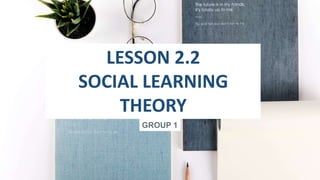
Social-Learning theory by Albert Bandura
- 2. Social Learning Albert Bandura's Social learning theory focuses on the learning that occurs within a social context. It considers that people learn from one another, including such concepts as observational learning, Imitation and modeling. The ten-year old boy Sergio Pelico did watch Saddam's execution on TV and then must have imitated it. Among others, Albert Bandura is considered the leading proponent of this theory.
- 3. General principles of social learning theory 3 2 4 People can learn by observing the behavior of others and the outcomes of those behaviors. 1 Learning can occur without a change in behavior. Cognition plays a role in learning. Social learning theory can be considered a bridge or a transition between behaviorist learning theories and cognitive learning theories.
- 4. How the environment reinforces and punishes modeling People are often reinforced for modeling the behavior of others. Bandura suggested that the environment also reinforces modeling. This is in several possible ways: 1. 2. 3. 4. The initiated behavior itself leads to reinforcing consequences. Many behaviors that we learn from others produce satisfying or reinforcing results. The observer is reinforced by a third person. The observer might be modeling the actions of someone else. Consequences of the model's behavior affect the observer's behavior vicariously. This is known as vicarious reinforcement. The observer is reinforced by the model.
- 5. Contemporary social learning perspective of reinforcement and punishment 1. 2. 3. 4. The expectation of reinforcement influences cognitive processes that promote learning. Therefore, attentions pay a critical role in learning, and attention is influenced by the expectation of reinforcement. Reinforcement and punishment influence the extent to which an individual exhibits a behavior that has been learned. Contemporary theory proposes that both reinforcement and punishment have indirect effects on learning. They are not the sole or main cause.
- 6. Cognitive factors in social learning Social learning theory has cognitive factors as well as behaviorist factors (actually operant factors) 1. Learning without performance: Bandura makes a distinction between learning through observation and the actual imitation distinction between learned. This is similar to Tolman's latent learning. 2. Cognitive processing during learning: Social learning theorists' content that attention is a critical factor in learning. 3. Expectations: As a result of being reinforced, people form expectations about the consequences that future behaviors are likely to bring. They expect certain behaviors to bring reinforcements and others to bring punishment. The leaner needs to be aware, however, of the response reinforcements and response punishment. Reinforcement increases a response only enter the learner is aware of that connection.
- 7. 4. Reciprocal causation: bandura proposed that behavior can influence both the environment and the person, in fat each of these three variables, the person, the behavior, and the environment can have an influence on each other. 5. Modeling: There are different types of models. There is the live model, an actual person demonstrating the behavior. There can also be a symbolic model, which can be a person or action portrayed in some other medium, such as television, videotape, computer programs.
- 8. Behaviors that can be learned through modeling Many behaviors can be learned, at least partly, through modeling. Examples that can be cited are, students can watch parents read, students can watch the demonstrations of mathematics problems, or see someone act bravely in a fearful situation. Aggression can be learned through models. Research indicates that children become more aggressive when they observed aggressive or violent models. Moral thin king and moral behavior are influenced by observation and modeling. This includes moral judgments regarding right and wrong which can, in part, develop through modeling.
- 9. Conditions necessary for effective modeling to occur Bandura mentions four conditions that are necessary before an individual can successfully model the behavior of someone else. 3 2 4 Attention - the person must first pay attention to the model. 1 Retention - the observer must be able to remember the behavior that has been observed. One way of increasing this is using the technique of rehearsal. Motor reproduction - the third condition is the ability to replicate the behavior that the model has just demonstrated. This means that the observer has to be able to replicate the action, which could be a problem with a learner who is not ready developmentally to replicate the action. For example, little children have difficulty doing complex physical motion. Motivation - the final necessary ingredient for modeling to occur motivation, learners must want to demonstrate what they have learned
- 10. 02 1. Educational Implications of social learning theory Students often learn a great deal simply by observing other people. 2. Describing the consequences of behavior can effectively increase the appropriate behaviors and decrease inappropriate ones. This can involve discussing with learners about the rewards and consequences of various behaviors. 3. Modeling provides an alternative to shaping for teaching new behaviors. Instead of using shaping, which is operant conditioning, modeling can provide a faster, more efficient means for teaching new behavior. To promote effective modeling, a teacher must make sure that the four essential conditions exist, attention, retention, motor reproduction, and motivation.
- 11. 02 4. Teachers and parents must model appropriate behaviors and take care that they do not model inappropriate behaviors 5. Teachers should expose students to a variety of other models